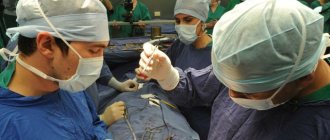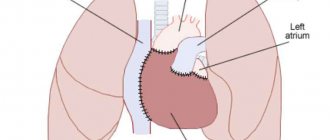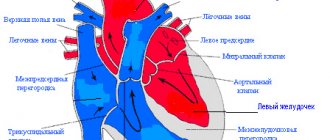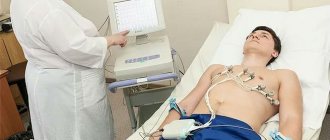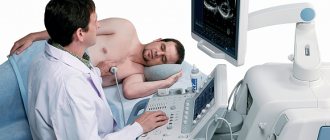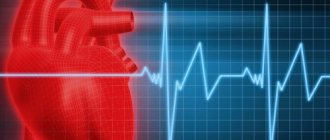Consultation with a cardiologist – RUB 1,750.
- Symptoms
- Diagnostics
- Treatment
Heart disease is a disease associated with anatomical abnormalities in the structure of the heart, namely valves, septa, and cardiac openings. As a result of the formation of this pathology, the functioning of the heart is disrupted and oxygen deficiency of organs and tissues of the body is formed, which can ultimately lead to heart failure.
Heart defects are divided into:
- congenital - the formation of pathology occurs at the stage of organ formation in the fetus as a result of exposure to endogenous or exogenous factors;
- acquired - occurrence is possible at any age under the influence of atherosclerosis, cardiosclerosis, ischemic or hypertension disease, rheumatism.
It is also customary to highlight:
- “white” type defects – there is no tendency to mix arterial and venous blood;
- “blue” type defects - venous blood enters the arterial bed, resulting in oxygen deficiency.
By the number of anatomical disorders:
- isolated - single lesions;
- combined – several anatomical elements of the heart suffer.
Symptoms of heart failure
In the clinical picture of the disease, there are general symptoms and specific ones, determined by the anatomical location of the defect. Common symptoms include:
- weakness and decreased ability to work;
- dizziness and fainting;
- shortness of breath and cyanosis (blue discoloration) of the skin;
- feeling of heartbeat;
- increase or decrease in blood pressure.
All these signs are the first signals and can only indirectly indicate the presence of heart disease.
What should you know about heart defects in adulthood?
Common defects in which patients survive into adulthood include:
- bicuspid aortic valve;
- coarctation of the aorta;
- pulmonary valve stenosis;
- atrial septal defect;
- open arterial (Botallov) duct.
“Patients need constant monitoring by a cardiologist to monitor the condition of the cardiovascular system. If heart failure develops, drug or surgical treatment is prescribed,” the specialist emphasizes.
Naturally, many people are also concerned about the prognosis in the presence of such defects. “The prognosis largely depends on the type of defect, the presence of concomitant diseases and decompensation of the condition. If necessary, surgical treatment is performed, which significantly improves the life prognosis,” notes the specialist.
Generation of Broken Hearts. Why does every second person have hypertension today? More details
Diagnostics
The diagnosis is established on the basis of complaints and objective examination data. During the examination, the doctor may pay attention to a lagging pulse in one of the arms, the presence of pathological noises when listening to the heart, and the presence of chest deformities. To confirm this disease, a number of instrumental studies are carried out:
- Ultrasound of the heart;
- ECG and echocardiography of the heart;
- X-ray examination;
- MSCT and MRI of the heart;
- phonography.
When diagnosing congenital heart defects, examination of a pregnant woman is of great importance. To do this, they also resort to ultrasound and invasive prenatal diagnostic methods, such as amniocentesis. If a defect is suspected, the child is immediately transferred to a specialized department after birth.
What is heart disease
Heart disease is a pathology characterized by anatomical disorders of the structures of the heart muscle, valves, septa or large vessels that supply it with blood. The heart cannot cope with its job of supplying the organs with oxygen. They experience oxygen starvation and are in serious danger. There are acquired and congenital heart defects.
Congenital defect
Congenital heart disease is an anomaly in the structure of blood vessels and the heart, which, for various reasons, arose during the intrauterine development of the fetus. Pathology occupies one of the first places among congenital deformations of organs that can cause the death of newborns before they reach one year of age.
Often, congenital heart disease does not manifest itself in the prenatal phase. It happens that the pathology remains unnoticed during the first years of the baby’s life. But over time, she will definitely remind herself.
Responsibility for the occurrence of pathology lies primarily with the child’s parents. Their diseases, heredity and lifestyle directly affect the health of the unborn baby. The development of heart disease can be triggered by:
- infectious diseases;
- taking certain medications;
- addiction to alcohol;
- drug use;
- exposure to radiation;
- pathologies of the endocrine system;
- severe toxicosis during pregnancy;
- advanced age of the mother;
- bad heredity;
- chromosomal disorders.
There are several types of congenital heart defects:
- open holes in the heart muscle;
- blood flow difficulties;
- pathologies of blood vessels;
- heart valve defects;
- tetralogy of Fallot;
- aortic stenosis;
- common trunk of arteries;
- Ebstein's anomaly;
- simultaneous manifestation of several types.
An anomaly detected immediately after birth will allow timely treatment to begin and reduce the risk of death of the baby during the first days of life. Before planning offspring, it is necessary to find out how healthy the future parents are. You should ask your other “halves” whether they have genetic problems or cases of congenital heart disease in their immediate relatives.
- Heart defects: classification, diagnosis, treatment and prevention
If a heart pathology is detected in the fetus during development, the mother is prescribed appropriate therapy during pregnancy. It should support the baby's cardiac functions until birth.
Heart disease in children
Timely treatment of pathology prevents the occurrence of complications. Children can grow and develop on par with healthy peers. Not all heart defects require emergency surgery. If so, specialists take a wait-and-see approach, keeping the cardiac activity of their patients under control. But in any case, a child with a heart defect needs special conditions for growing up.
Visually, symptoms of pathology usually appear when the baby turns three years old. At this time, attentive parents may notice:
- slow physical development of the baby;
- pallor of the skin, sometimes cyanosis;
- the appearance of shortness of breath during habitual movements.
Children with congenital heart disease are characterized by psycho-emotional experiences due to problems with development and learning. Typically, sick children begin to walk, talk, read and write later than their healthy peers. Over time, the situation can be aggravated by the appearance of excess weight, although initially, children with congenital heart disease are registered as underweight. A sick child's immunity is low, so he is at risk of infectious diseases.
But it's not just congenital heart defects that affect children. Adolescents are often diagnosed with acquired defects. This type of pathology can occur during exacerbation of various ailments. Harmful bacteria can enter the bloodstream:
- through infection during injection (contaminated syringes and needles);
- in case of violations of sanitation during medical procedures (including dental procedures);
- when abscesses occur.
Blue and white vices
There are blue and white heart defects. When blue, there is a reflux of venous blood into the arterial bed. In this case, the heart muscle “pumps” blood depleted of oxygen. The pathology is characterized by the early manifestation of symptoms of heart failure:
- cyanosis (blue color);
- dyspnea;
- nervous overexcitation;
- fainting.
With white defects, venous and arterial blood do not mix, oxygen enters the organs in the required quantity. The pathology is characterized by the same attacks that are observed with blue defects, but they appear later - at 8-12 years.
Medical practice shows that people with heart defects often live full lives without experiencing suffering or discomfort.
Acquired vice
Acquired heart defects affect the heart valves. Serious pathologies become the “trigger” for their development:
- Treatment of heart disease with folk remedies
- chronic vascular diseases (atherosclerosis);
- systemic connective tissue lesions (rheumatism, dermatomyositis, scleroderma);
- inflammation of the endocardium (infectious endocarditis);
- systemic joint diseases (Bechterew's disease);
- systemic venereal diseases (syphilis).
The cause of acquired heart defects is often the death of cells in the heart valves. Injuries can provoke the course of pathology.
There are compensated and decompensated acquired defects. In the first case there are no obvious symptoms of circulatory failure, in the second these symptoms are present.
The symptoms of the pathology are similar to those of other vascular and heart diseases. Therefore, the diagnosis is made only based on the results of an examination, including echo and electrocardiography. Some acquired heart defects include:
- Mitral - manifested by prolapse (sagging of the leaflets) of the mitral valve. Treatment is symptomatic. In parallel with it, drug therapy is carried out for the pathology that caused the heart defect. In case of serious damage to the valve, surgical correction is indicated;
- Aortic – the aortic valve is affected. The main pathology is treated with medication. Treatment of heart disease may require surgery, including valve transplantation;
- Combined - two or more valves of the heart muscle are affected. The mitral, tricuspid and aortic valves may become deformed, which will cause difficulties in diagnosing and treating the pathology. Most often, mitral valve insufficiency and mitral stenosis occur simultaneously. Under such circumstances, cyanosis and severe shortness of breath appear;
- Combined - one valve is subject to several violations. This is usually stenosis and failure. When diagnosing this type of heart defect, the severity of the lesions and the predominance of one of them are determined. This is necessary to prescribe adequate treatment and the type of possible surgical intervention;
- Compensated – difficult to diagnose, asymptomatic pathology. Dysfunctions of some parts of the heart muscle are fully compensated by the increased load on other parts of the heart. Only an experienced cardiologist, who has high-tech special equipment at his disposal, can diagnose this defect.
“Simple”, isolated heart defects are much less common than “complex”, combined ones. Infectious ailments haunt patients for years, affecting muscle tissue. As a result, another is added to one vice.
Treatment
When treating heart disease, a regimen of limited physical activity is prescribed. The following are used as drug treatments:
- antihypertensive drugs;
- β-blockers;
- anticoagulants.
Most often, the most effective treatment option for heart disease is surgery. It is aimed at completely eliminating the cause of disturbances in the functioning of the heart. This can be either an organ-preserving operation or prosthetics of the affected anatomical structure.
What is the difference between VPS and PPS
Cardiopathy acquired at one of the life stages and congenital cardiopathy have significant differences. And the difference concerns not only the nature of the formation of defects. Here it is important to pay attention to the nuances, signs of pathology, and the mechanics of disorders. It is best to evaluate the difference between the two options by looking at the table.
| Variety | Name | Clinic (picture) | Failure of blood movement, that is, hemodynamics |
| Without bluing of the integument (VPS) | Damage to the partitions between the ventricles and atria. | Systolic murmur in the left side of the chest, protrusion of the anterior wall. | Blood is dumped from left to right. Reflex arterial spasm leads to an increase in pulmonary pressure. The left ventricle is overloaded. |
| PDA when the duct is not closed. | A systolic-diastolic murmur is heard in the left side of the chest. | In the small circle, blood flow increases. The left side parts are overloaded. Discharge occurs from the aorta to the pulmonary artery. | |
| Stenosis (heart disease). Narrowing of the lumen of the pulmonary artery. | There is a rough systolic murmur over the PA valve. | The right ventricle receives a high load, the pulmonary blood flow is pooled. | |
| Narrowing of the lumen – coarctation. | High blood pressure, murmurs along the left thoracic border. | The left ventricle receives a high load; insufficient lumen interferes with normal blood flow. | |
| With blue discoloration (VPS) | TMS – vascular transposition. | Hypoxia, quite pronounced. | The nutrition of the organs is disrupted. |
| One ventricle. | Systolic murmurs at the top, hypoxia. | Venous and arterial blood mix, the speed of its movement increases. | |
| Fallot | This is a notebook | Blood is dumped from right to left | |
| Mitral valve related PPS | Failure. | Systolic murmur at the apex. | Reverse blood flow into the atrium on the left side. |
| Stenosis. | Diastolic murmur at the apex. | The atrium on the left side is overloaded, dilated, hypertrophied. | |
| AVR (aortic heart disease) | Valve insufficiency. | The carotid arteries pulsate noticeably. Blood pressure is increased (pulse). | The left ventricle is distended due to backflow. |
| Narrowing of AK. | Fainting, pain similar to angina pectoris. | The release of blood into the aorta is impaired. | |
| PKLA | PA valve insufficiency. | On the valve, tone II is weakened. | When moving, the blood is again thrown into the ventricle on the right. |
| LA narrowing. | The ventricle on the right side is noticeably pulsating. | Release into the pulmonary artery is difficult. | |
| Tricuspid valve injuries | Failure. | There is a systolic murmur. | Rejection of blood into the right atrium. |
| Stenosis. | Tone I is strengthened. | The right atrium becomes overloaded and expands. Hypertrophy is observed. |
Consequences of pathology
It all depends on the form and well-formed medical prescriptions. If you detect the danger in a timely manner, contact a medical professional, undergo a thorough examination, and determine the pathology, you can significantly improve your quality of life. Mild types of lesions are usually not fatal. By taking medications, you can feel quite healthy, be careful, but engage in various types of activities.
It is convenient to obtain accurate information on a specific case from the treating cardiologist-specialist. The doctor will analyze the existing features and give a prognosis and tell you about the possible consequences.
Life expectancy
Despite the seriousness of this disease, patients should not despair. Today, there are many techniques that can stabilize the condition, alleviate symptoms and slow down the progression of pathology.
Important! This time can be used for a detailed examination of the body and preparation for surgical treatment, which ensures complete normalization of blood flow and hemodynamics, and contributes to a significant improvement in well-being.
The prognosis of patients also depends on the type of defect and its severity. Congenital defects tend to be worse and can cause early death. However, with timely detection and surgical treatment, it is possible to achieve normalization of heart function. But without surgery, patients do not live long, since already at the initial stages they experience significant disturbances in the body.
In the case of acquired defects the situation is different. This pathology does not lead to a rapid deterioration of the condition and a sharp increase in the risk of death. However, the presence of a defect means that the patient has a hemodynamic disorder. In addition, the disease that caused the development of the defect also plays a certain role. After all, even with valve replacement, chronic pathologies of the cardiovascular system do not disappear anywhere and can cause other dangerous conditions.
All this leads to the fact that the heart has to work in unfavorable conditions, it becomes exhausted, and patients develop or worsen heart failure and coronary heart disease.
Remember! As a result, how quickly the correct diagnosis is made plays a huge role.
If you start treatment in the early stages, you can significantly slow down or stop the progression of the pathology. In addition, surgical treatment is highly effective. But if you miss the time, then even after the operation the patient will suffer from various complications caused by prolonged overload of the heart.
Acquired heart defects
A number of diseases cause secondary structural changes in the heart valves. These are vices. What kind of diseases are these:
- systemic pathologies affecting connective tissue - systemic lupus erythematosus, rheumatoid arthritis;
- infective endocarditis;
- atherosclerosis;
- myocardial infarction;
- traumatic heart injuries (including those received during surgery);
- carcinoid syndrome, etc.
Valves are “doors” for the passage of blood from vessels to the heart, from the heart to vessels and between the parts of the heart (atrium and ventricle). Their defects are of two types:
- “under-opening” of doors - stenosis, as a result of which blood cannot freely pass into the corresponding space;
- constantly “open doors” - valve insufficiency, as a result of which blood can pass not only in the forward direction, but also in the opposite direction.

